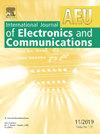基于多倍频程模式转移的谐波调谐功率放大器
IF 3.2
3区 计算机科学
Q2 ENGINEERING, ELECTRICAL & ELECTRONIC
Aeu-International Journal of Electronics and Communications
Pub Date : 2025-08-10
DOI:10.1016/j.aeue.2025.155975
引用次数: 0
摘要
本文提出了两种新型扩展连续模式功率放大器:扩展连续模式f类(ECCF-3)和扩展连续模式反f类(ECCF−1-3)。这两种新的扩展模式为基频阻抗、二次谐波和三次谐波阻抗提供了新的扩展设计空间。特别是,与其他连续模态相比,三次谐波阻抗可以具有非零实部,并且可以覆盖较大的史密斯图面积。在所提出的模式中,第二和第三次谐波阻抗之间的重叠也是合理的,提供了谐波调谐宽带功率放大器实际设计的最大兼容性,带宽超过一个倍频程。为了验证所提出的分类和设计方法,使用35w GaN HEMT实现了一个基于多倍频阶模式转移的谐波调谐功率放大器(MMHPA)。该功率放大器工作在0.35-2.15 GHz频段,实现了两个倍频以上的带宽。在此工作频段内,MMHPA的实测输出功率为41.8-46.2 dBm,漏极效率(DE)为57% - 72%,功率增益为8.2-12.2 dB。本文章由计算机程序翻译,如有差异,请以英文原文为准。
A Multi-Octave mode transfer-based harmonic tuned power amplifier (MMHPA)
This paper presents two new extended continuous mode Power amplifiers: Extended Continuous Mode Class-F (ECCF-3) and Extended Continuous Mode Inverse Class-F (ECCF−1-3). These two new extended modes offer a new extended design space for fundamental impedance, second and third harmonic impedances. Particularly, third harmonic impedances can have a non-zero real part and can cover a large area of Smith chart compared to other continuous modes. In proposed modes, the overlap between second and third harmonic impedances is also justified, providing most compatibility with harmonic tuned broadband power amplifier practical design, with more than one-octave bandwidth. To validate the proposed classes and design method, a Multi-Octave Mode Transfer-based Harmonic Tuned Power Amplifier (MMHPA) is implemented using a 35-W GaN HEMT. The fabricated Power Amplifier, operating at 0.35–2.15 GHz frequency band, achieves a bandwidth of more than two octaves. Within this operating band, the MMHPA exhibits a measured output power of 41.8–46.2 dBm, a drain efficiency (DE) of 57 %–72 %, and a power gain of 8.2–12.2 dB.
求助全文
通过发布文献求助,成功后即可免费获取论文全文。
去求助
来源期刊
CiteScore
6.90
自引率
18.80%
发文量
292
审稿时长
4.9 months
期刊介绍:
AEÜ is an international scientific journal which publishes both original works and invited tutorials. The journal''s scope covers all aspects of theory and design of circuits, systems and devices for electronics, signal processing, and communication, including:
signal and system theory, digital signal processing
network theory and circuit design
information theory, communication theory and techniques, modulation, source and channel coding
switching theory and techniques, communication protocols
optical communications
microwave theory and techniques, radar, sonar
antennas, wave propagation
AEÜ publishes full papers and letters with very short turn around time but a high standard review process. Review cycles are typically finished within twelve weeks by application of modern electronic communication facilities.

 求助内容:
求助内容: 应助结果提醒方式:
应助结果提醒方式:


